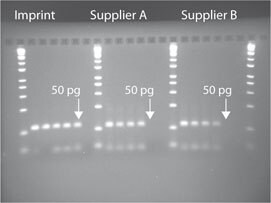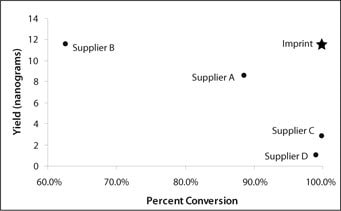DNA Methylation & Bisulfite Conversion
There are several common ways to determine whether a gene contains methylated DNA. Since mammalian methylation occurs at cytosines, researchers take advantage of the fact that methylated cytosine (meC) is stable to bisulfite treatment but unmethylated cytosine is transformed to uracil under the same conditions. Bisulfite treatment, manifested as our Imprint® DNA Modification Kit (Product No. MOD50), converts unmethylated cytosine to uracil. These treated samples can be sequenced to determine the methylation state of the original sample, a process termed bisulfite sequencing. This treatment can also be used to perform methylation-specific PCR, which exploits the C to U change and uses primers that will anneal based on those predicted changes. Bisulfite treatment of DNA is a prerequisite for DNA methylation analysis for many epigenetics-based studies involving methylation profiling and the quantification of methylation status.
Our scientific team systematically investigated the bisulfite treatment of DNA. They studied the chemistries involved in the process and the conversion rates in an effort to limit variability between samples and to improve yield over the conventional methods. They standardized the incubation reaction times, temperature, and pH. The protocol that was developed increased the recovery yields up to 90% of input DNA with >99% C to U conversion. The method has been developed to accommodate purified DNA from biological fluids, cells, or tissue directly as the input material.
Features and Benefits
- One of the fastest bisulfite modification kits available — requires less than two hours
- Small amount of starting material needed for modification — requires only 50 picograms of DNA or 20 cells
- Greater than 99% unmethylated cytosine deaminated to uracil
- Extremely low degradation — greater than 90% of input DNA is recovered
- Option of convenient one-step protocol
- Consistent and reproducible bisulfite conversion

Figure 1.The Imprint® DNA Modification Kit provides better sensitivity than kits from other suppliers. Bisulfite modification was performed on decreasing concentrations of human genomic DNA using Imprint® DNA Modification Kit (Product No. MOD50) and kits from two other suppliers. Methylation-specific PCR (MSP) was then performed on all samples using ß-actin gene-specific primers (109 bp amplicon). For all suppliers lanes from left to right are 100 ng, 10 ng, 1 ng, 100 pg, 50 pg, and no sample, respectively. Suppliers C and D (not shown) have no product at 50 pg. These results demonstrate the superior sensitivity of the Imprint® kit relative to other suppliers' kits.

Figure 2.Best-in-Class Yield and Conversion. Human genomic DNA (100 ng) was bisulfite treated according to each supplier’s protocol followed by qPCR analysis. The modified and unmodified primer sets within the ß-actin gene were then used to determine bisulfite yield. Ct values were compared to the Ct value of a 10-ng human genomic standard. Percent conversion was determined after busulfite modification of 100 ng of human genomic DNA. Comparison of qPCR delta Ct values between modified and unmodified primers within ß-actin demonstrates conversion rates. The graph above highlights the superior yield and conversion rates of the The Imprint kit in relation to other suppliers. Bisulfite sequencing can also be performed after chromatin immunoprecipitation (ChIP-BS), which could be useful for examining DNA methylation status in combination with histone modification on a relatively large scale.
MATERIALS
To continue reading please sign in or create an account.
Don't Have An Account?